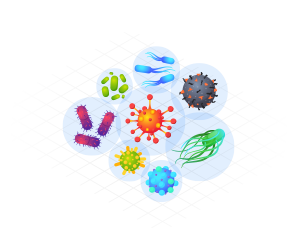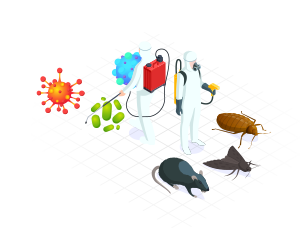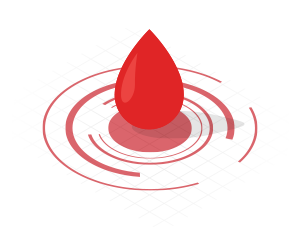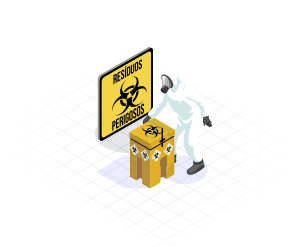


bacteria, viruses, fungi and parasites, as well as genetically modified microorganisms, cell cultures and human endoparasites.

These agents can cause infections, allergies or poisoning, depending on their nature and level of exposure.
Although they are naturally present in the environment, only a small proportion of these microorganisms pose a threat to health, as they are pathogenic biological agents that are distinguished by their ability to overcome the body's defenses and cause disease, putting the safety and health of those exposed to these agents at risk.
Main Pathogens

Microorganisms are pathogens capable of causing disease in humans, animals, and plants. They include bacteria, viruses, fungi, and parasites, and can cause infections ranging in severity from mild to life-threatening.

These organisms are distinguished by their ability to invade living tissue, multiply, and interfere with the normal functioning of the host organism. Transmission can occur in a variety of ways, including direct contact between living beings, inhalation of infected particles, consumption of contaminated food or water, bites from vector insects, or contact with contaminated surfaces.
Your rating

Biological agents are classified, according to their level of infectious risk, based on the annex to Order No. 405/98 of 11 July 1998, into the following groups:

- Group 1 biological agent: The probability of causing disease in humans is low.
The health consequences

Exposure to biological agents, such as bacteria, viruses, fungi and parasites, can have several consequences for human health, depending on the nature of the agent, the level of exposure and the individual conditions of each person.

The effects can range from mild, transient infections to serious, chronic illnesses, and in some cases, can lead to death.
DEATHCLEAN IS THE SOLUTION

Exposure to biological agents can have serious health consequences, including infections, allergies, poisoning, and chronic diseases. Proper prevention and control are essential to reduce risks, enabling the implementation of effective protection strategies, and promoting a safer environment for all.

THE DEATHCLEAN®is the only company in Portugal internationally certified to operate in biological risk scenarios, offering specialized equipment, advanced disinfection products, and highly qualified professionals to ensure an effective and safe service.
RELATED INFORMATION

What are biological agents?
Biological agents are living microorganisms that can pose a risk to human health, including bacteria, viruses, fungi, and parasites, as well as genetically modified microorganisms, cell cultures, and human endoparasites. These agents can cause infections, allergies, or poisoning, depending on their nature and level of exposure.
Although naturally present in the environment, only a small proportion of these microorganisms pose a health threat. Pathogenic biological agents are distinguished by their ability to overcome the body's defenses and cause disease, putting the safety and health of those exposed to them at risk. One of the main differences between biological agents and chemical substances lies in their reproductive capacity. Under favorable conditions, a small number of microorganisms can multiply rapidly, significantly increasing the risk of contamination.
Exposure to biological agents requires strict preventive measures, especially in sectors such as healthcare, specialized cleaning, and waste treatment. Adopting good practices, using personal protective equipment, and implementing biosafety protocols are essential to reducing the risk of contamination, as many of these agents can be transmitted through bodily fluids, inhalation of airborne particles, contact with contaminated surfaces, or direct handling of contaminated materials, making their spread particularly worrying.

Main Pathogens
Pathogens are microorganisms capable of causing disease in humans, animals, and plants. They include bacteria, viruses, fungi, and parasites, and can cause infections ranging in severity from mild to life-threatening.
These organisms are distinguished by their ability to invade living tissue, multiply, and interfere with the normal functioning of the host organism. Transmission can occur in a variety of ways, including direct contact between living beings, inhalation of infected particles, consumption of contaminated food or water, bites from vector insects, or contact with contaminated surfaces.
Furthermore, some diseases caused by pathogens can be zoonotic, meaning they can be transmitted between animals and humans. Examples include avian flu, leptospirosis, plague, and rabies. Therefore, pathogens represent a global concern, affecting not only human health but also animal and plant life, making it essential to adopt control and prevention measures across various sectors.
- Virus: Smaller, highly contagious pathogens that always require a host (a living being that is infected) to reproduce. The most common infection mechanism is the introduction of their genetic material into the host's cells, where they replicate at the expense of the cell until they are destroyed, then go on to infect other cells. Examples of diseases or infections include the flu, COVID-19, measles, AIDS, and viral hepatitis.
- Bacteria: They are simple organisms that can survive and multiply rapidly within the body without needing a host to complete their development, provided they have a favorable environment. Examples of diseases or infections include tuberculosis, pneumonia, and bacterial meningitis, cholera, anthrax, typhoid fever, leprosy, and salmonella infections.
- Fungi: They are more complex life forms, whose natural habitat is soil and which reproduce through spores. They are widely distributed in nature and play an essential role in the decomposition of organic matter. However, some species of fungi cause infections in humans, animals, and plants. Examples of diseases or infections include aspergillosis, histoplasmosis, cryptococcosis, and fungal meningitis.
- Parasites: These are organisms that live in association with others from which they derive the means for their survival, usually harming the host organism. These organisms can cause a variety of diseases, ranging in severity from mild infections to life-threatening conditions. Examples of diseases or infections include malaria, toxoplasmosis, leishmaniasis, scabies, Lyme disease, giardiasis, and intestinal infections.

Your rating
Biological agents are classified, according to their level of infectious risk, based on the annex to Order No. 405/98 of 11 July 1998, into the following groups:
- Group 1 biological agent: The probability of causing disease in humans is low.
- Group 2 biological agent: It can cause disease in humans and pose a danger to workers, with little chance of spreading within the community. Effective prophylaxis and treatment are generally available. Examples include Staphylococcus aureus, Salmonella enterica, Candida albicans, and Herpes simplex virus.
- Group 3 biological agent: It can cause serious illness in humans and pose a serious risk to workers, and is likely to spread within the community, even if effective prophylaxis or treatment are available. Examples include Bacillus anthracis, Mycobacterium tuberculosis, Yersinia pestis, and SARS-CoV.
- Group 4 biological agent: It causes serious illness in humans and poses a serious risk to workers. It is likely to spread rapidly within the community and for which there are generally no effective prophylaxis or treatment methods. Examples include the Ebola virus, Marburg virus, smallpox virus, and Lassa virus.

The health consequences
Exposure to biological agents, such as bacteria, viruses, fungi, and parasites, can have a variety of consequences for human health, depending on the nature of the agent, the level of exposure, and each person's individual circumstances. Effects can range from mild, transient infections to severe, chronic illnesses, and in some cases, even death.
The main consequences of exposure to biological agents are:
- Infections: Infections occur when a biological agent invades the body and multiplies, triggering an immune response. The severity of the infection depends on the type of agent and the capacity of the person's immune system. Infections can include respiratory infections (Mycobacterium tuberculosis, SARS-CoV-2, influenza), gastrointestinal infections (Salmonella spp., Escherichia coli, Giardia lamblia), skin infections (Staphylococcus aureus, Candida albicans, Trichophyton spp.), and systemic infections (HIV, Leptospira spp., Plasmodium spp.).
- Allergies: Continuous exposure to certain biological agents can trigger allergic responses and chronic respiratory diseases, especially in occupational environments, such as respiratory allergies due to contact with fungal spores (Aspergillus spp., Penicillium spp.).
- The toxic effects: Some bacteria and fungi produce toxins (endotoxins or mycotoxins) capable of causing serious poisoning, affecting different organs and systems, such as botulinum toxin (botulism), which can cause muscle paralysis and respiratory failure.
- Chronic or cancerous diseases: Some infections caused by biological agents can trigger long-term illnesses or contribute to the development of cancers due to their ability to cause mutations or chronic inflammation, such as hepatitis B and C, the human papillomavirus, or even the Epstein-Barr virus.

DEATHCLEAN IS THE SOLUTION
Exposure to biological agents can have serious health consequences, including infections, allergies, poisoning, and chronic diseases. Proper prevention and control are essential to reduce risks, enabling the implementation of effective protection strategies, and promoting a safer environment for all.
THE DEATHCLEAN® is the only company in Portugal internationally certified to operate in biological risk scenarios, offering specialized equipment, advanced disinfection products, and highly qualified professionals to ensure an effective and safe service.
Many situations that require professional, certified intervention involve crime scenes, spaces affected by decomposition or extreme waste accumulation, as well as environments contaminated by potentially pathogenic viruses, bacteria, and fungi. In these cases, conventional cleaning is not enough; a rigorous decontamination protocol is required to eliminate invisible risks that can compromise public and individual health.
Knowledge of these risks is essential for individuals and businesses to make informed decisions about the need for qualified professional intervention. Environments contaminated by biological agents should not be treated with conventional methods, as inappropriate exposure can result in the spread of serious diseases. By relying on DEATHCLEAN®, guarantees a service that meets the highest safety and effectiveness standards, protecting people's health and restoring habitability to compromised spaces. We are the answer to biological risk situations, ensuring a safe environment for everyone.







